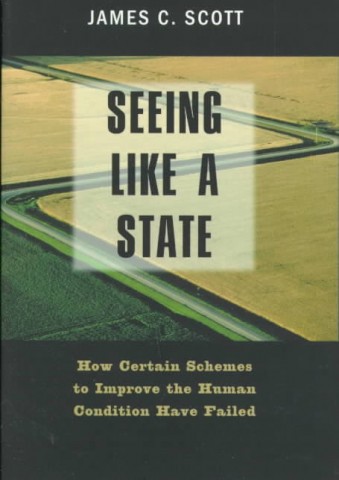Thought provoking quotes from Scott's (1998) Seeing Like A State: How Certain Schemes to Improve the Human Condition have Failed.
On simplification:
- "… state simplifications, the basic givens of modern statecraft, were, I began to realize, rather like abridged maps. They did not successfully represent the actual activity of the society they depicted, nor were they intended to; they represented only that slice of it that interested the official observer. They were, moreover, not just maps. Rather, they were maps that, when allied with state power, would enable much of the reality they depicted to be remade. Thus a state cadastral map created to designate taxable property-holders does not merely describe a system of land tenure; it creates such a system through its ability to give its categories the force of the law." (p. 3)
- "State simplifications have at least five characteristics that deserve emphasis. Most obviously, state simplifications are observations of only those aspects of social life that are of official interest. Second, they are also nearly always written (verbal or numerical) documentary facts. Third, they are typically static facts. Fourth, most stylized state facts are also aggregate facts…. Finally, for most purposes, state officials need to group citizens in ways that permit them to make a collective assessment. Facts that can be aggregated and presented as averages or distributions much therefore be standardized facts." (p. 80)
On standard setting:
- "Because local standards of measurement were tied to practical needs, because they reflected particular cropping patterns and agricultural technology, because they varied with climate and ecology, because they were "an attribute of power and an instrument of asserting class privilege," and because they were "at the center of bitter class struggle," they represented a mind-boggling problem for statecraft. Efforts to simplify or standardize measures recur like a leitmotif throughout French history – their reappearance a sure sign of previous failure." (p. 29)
- "…typifications are indispensable to statecraft. State simplifications such as maps, censuses, cadastral lists, and standard units of measurement represent techniques for grasping a large and complex reality; in order for officials to be able to comprehend aspects of the ensemble, that complex reality must be reduced to schematic categories. The only way to accomplish this is to reduce an infinite array of detail to a set of categories that will facilitate summary descriptions, comparisons, and aggregations." (p. 77)
On legibility:
- "Legibility is a condition of manipulation. Any substantial state intervention in society – to vaccinate a population, produce goods, mobilize labor, tax people and their property, conduct literacy campaigns, conscript soldiers, enforce sanitation standards, catch criminals, start universal schooling – requires the invention of units that are visible. The units in question might be citizens, villages, trees, fields, houses, or people grouped according to age, depending on the type of intervention. Whatever the units being manipulated, they must be organized in a manner that permits them to be identified, observed, recorded, counted, aggregated and monitored. The degree of knowledge required would have to be roughly commensurate with the depth of the intervention. In other words, one might say that the greater the manipulation envisaged, the greater the legibility required to effect it." (p. 183).
The impact:
- "The point is simply that high-modernist designs for life and production tend to diminish the skills, agility, initiative, and morale of their intended beneficiaries. They bring about a mild form of this institutional neurosis. Or, to put it in the utilitarian terms that many of their partisans would recognize, these designs tend to reduce the "human capital" of the workforce. Complex, diverse, animated environments contribute, as Jacobs saw, to producing a resilient, flexible, adept population that has more experience in confronting novel challenges and taking initiative. Narrow, planned environments, by contrast, foster a less skilled, less innovative, less resourceful population." (p. 349)
1618 Hits

